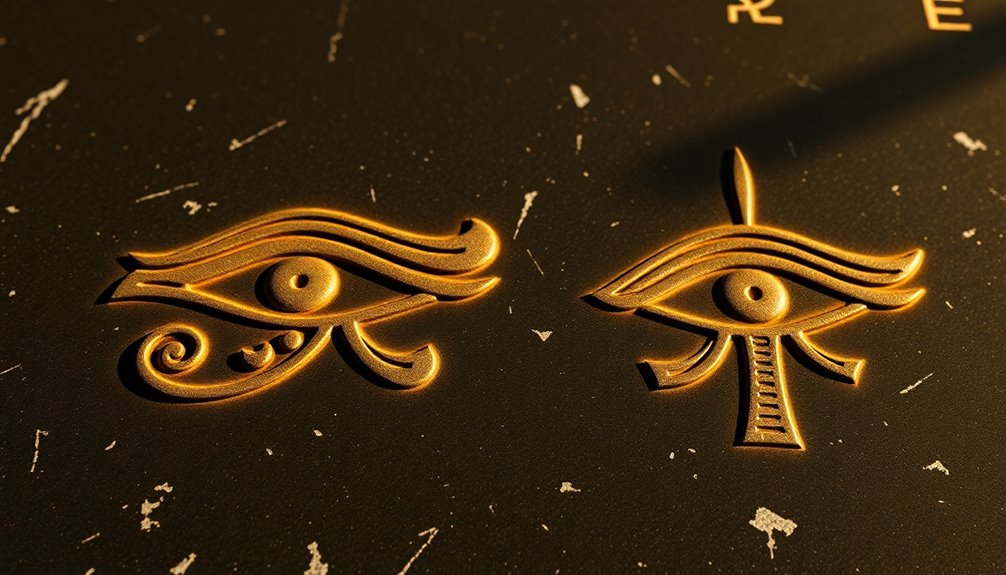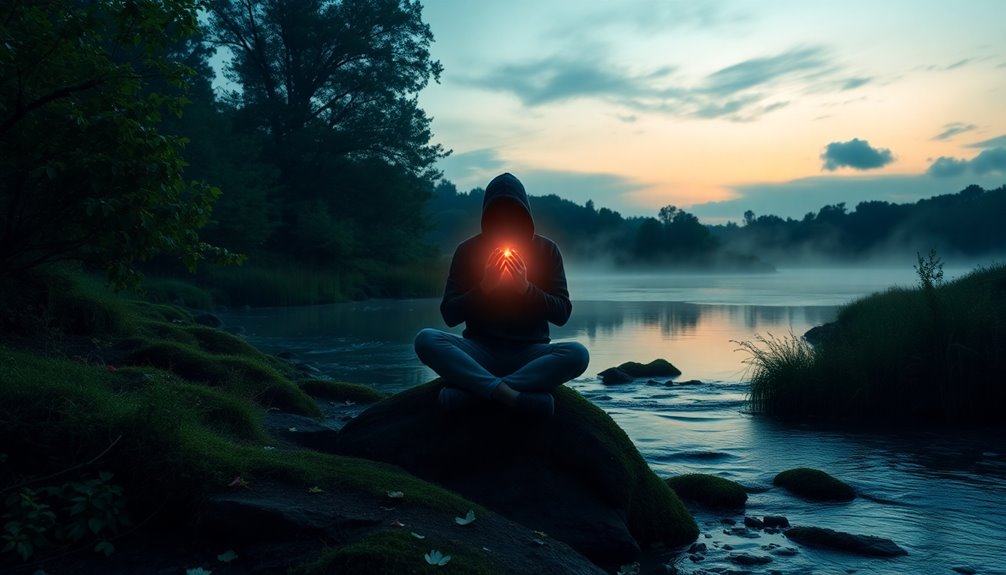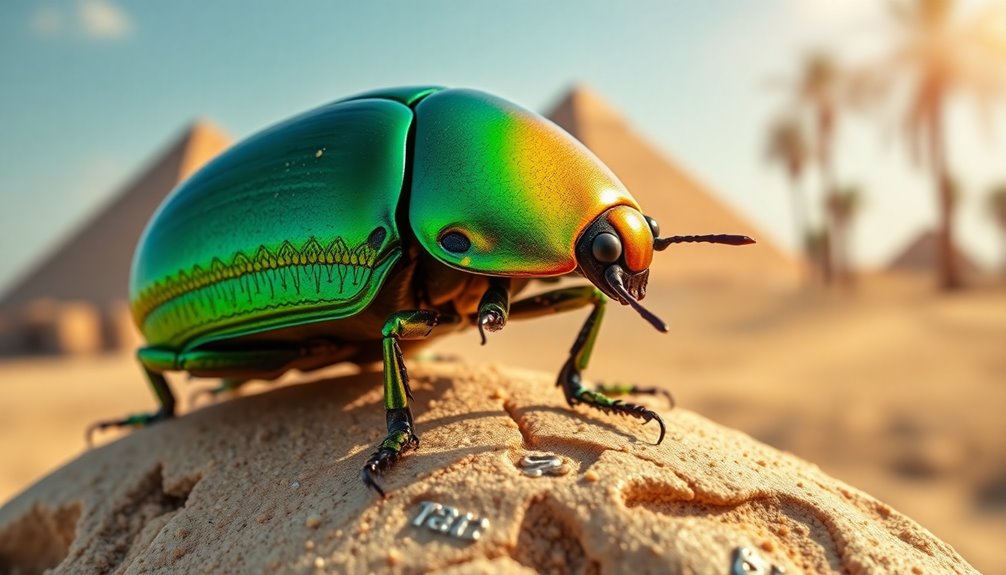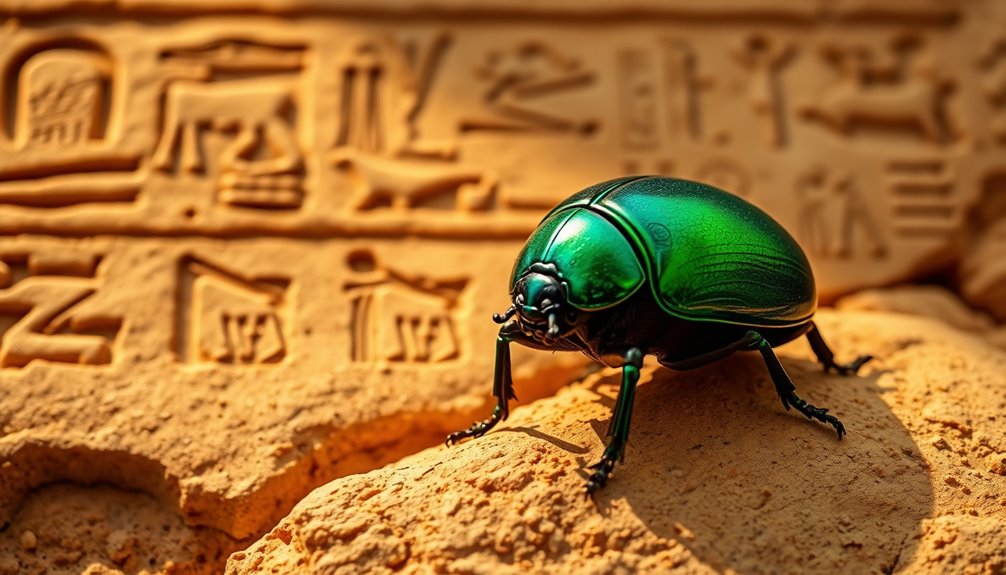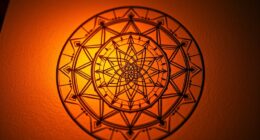When comparing the Eye of Horus and the Eye of Ra, it's clear each has its own power. The Eye of Horus symbolizes healing, protection, and wisdom, giving it a nurturing strength. In contrast, the Eye of Ra embodies might and wrath, representing the fierce protective nature of the sun god. While Horus's eye promotes safety and recovery, Ra's eye commands authority and can release chaos. So, determining which is more powerful depends on whether you value healing or dominance. If you want to explore their roles in mythology and culture further, there's much more to uncover.
Key Takeaways
- The Eye of Ra symbolizes power and wrath, representing the sun god's might and protective vengeance, making it appear more aggressive and dominant.
- The Eye of Horus embodies healing and protection, emphasizing resilience and recovery, presenting a nurturing aspect rather than sheer power.
- While the Eye of Ra is associated with chaos and destruction, the Eye of Horus represents safeguarding and health, reflecting different forms of strength.
- Both symbols serve protective purposes but illustrate a balance between power and healing, making neither inherently more powerful than the other.
- Cultural interpretations may favor one symbol over the other, but their significance varies based on context and the aspect being considered.
Background of Egyptian Symbols
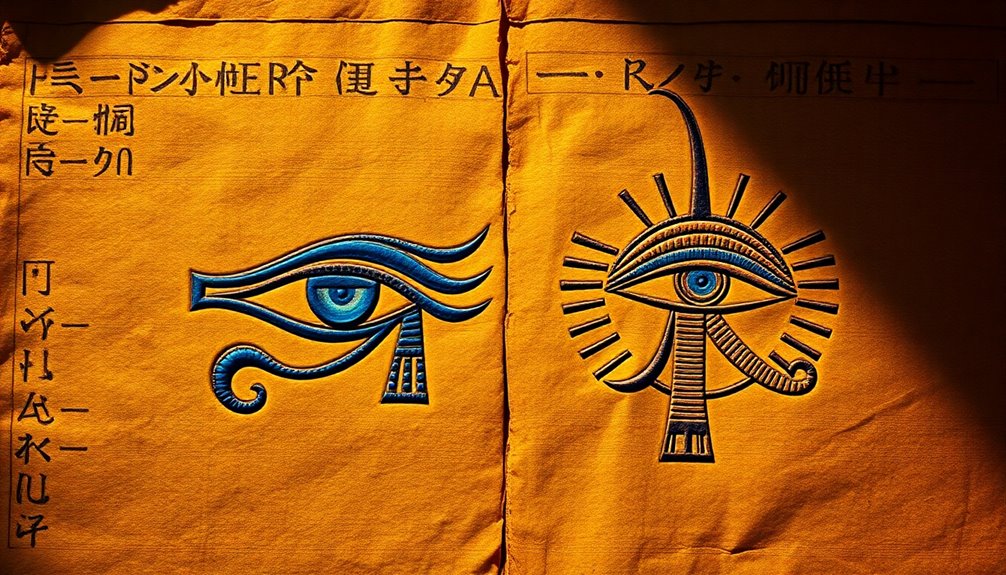
Delving into the rich tapestry of ancient Egyptian symbols, you'll find that each emblem carries profound meanings and narratives. The Eye of Horus, also known as the Wedjat, is a powerful symbol of healing, protection, and wisdom. Its origins lie in the mythology surrounding Horus avenging his father, Osiris. This emblem embodies completeness, as it's divided into six parts that correlate with the senses, reminding you of the holistic nature of existence.
On the other hand, the Eye of Ra represents the sun god Ra and is associated with power, wrath, and the destructive force of the sun. This symbol is often linked to Sekhmet, the fierce goddess who punishes enemies.
Both symbols were prevalent in ancient Egyptian art, jewelry, and amulets, serving as protective emblems for both pharaohs and ordinary citizens.
The duality of the Eye of Horus and the Eye of Ra reflects the ancient Egyptians' understanding of balance between creation and destruction. Together, they showcase the depth of their mythology and cultural beliefs, providing insight into how they viewed the world around them.
The Eye of Horus Explained
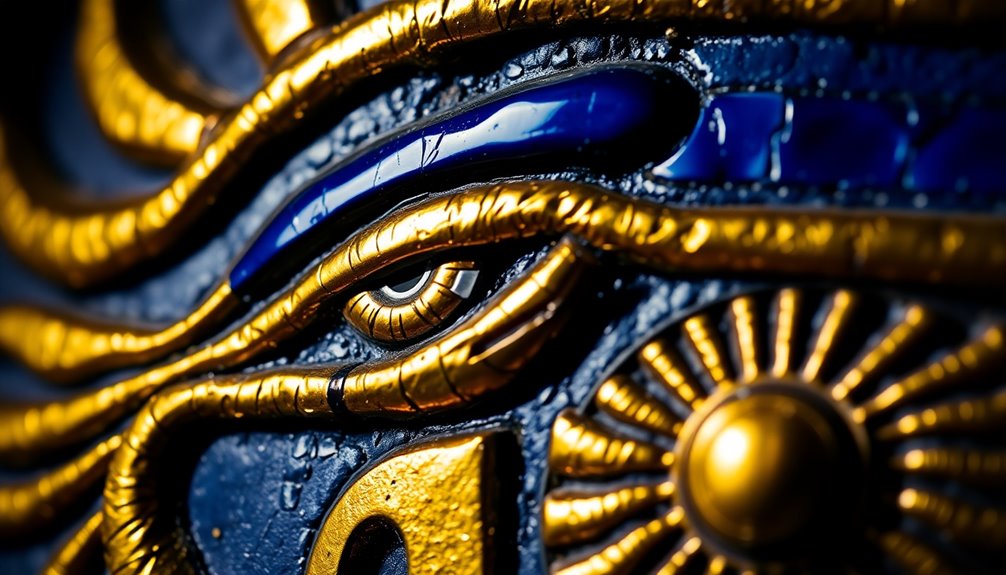
The Eye of Horus, or Wedjat, stands out among ancient Egyptian symbols for its deep associations with healing, protection, and restoration. Originating from the myth of Horus avenging his father Osiris, this powerful symbol represents resilience and the ability to overcome adversity.
The Eye of Horus is depicted as the left eye, often linked to the moon, embodying themes of regeneration and balance in ancient Egyptian culture.
Divided into six sections, each representing one of the senses, the Eye totals 63/64, symbolizing wholeness and health, while the missing 1/64 signifies imperfection. This intricate symbolism deepens its significance, as it reflects the balance between the physical and spiritual domains.
In ancient Egypt, the Eye of Horus frequently appeared in amulets, believed to ward off evil and grant good fortune to the wearer. This protective aspect further emphasizes its role in healing and restoration.
The legend of Horus losing his eye and its eventual restoration by Thoth reinforces the themes of recovery, making the Eye of Horus a crucial emblem of strength and protection throughout history.
The Eye of Ra Explained
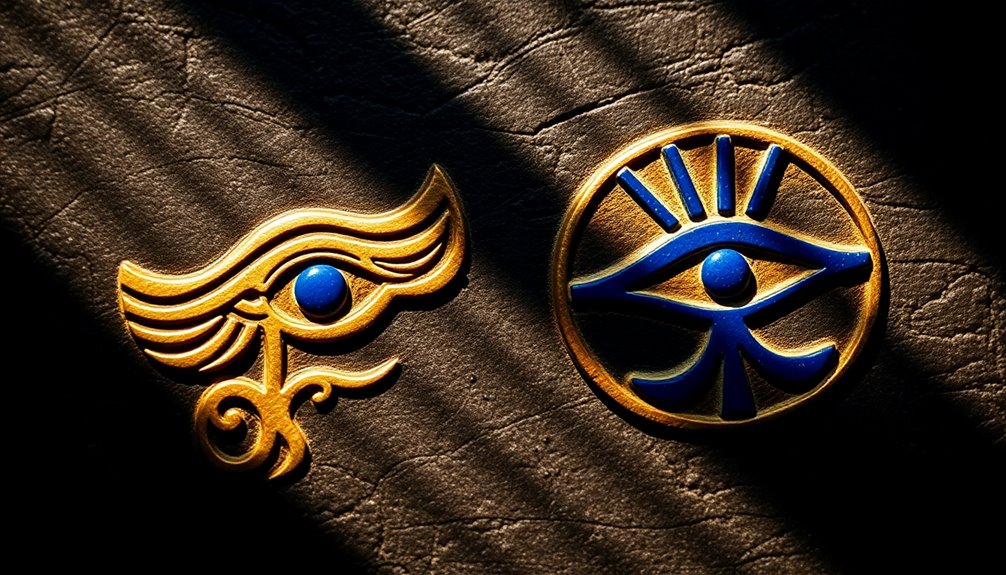
When you think of ancient Egyptian symbols, the Eye of Ra often comes to mind as a powerful emblem of the sun and divine authority. This symbol, typically depicted as the right eye, embodies the might and fury of the sun god Ra. It represents Ra's protective force, which can release vengeance on those who disrespect him.
In mythology, this often manifests through Ra's daughter, Sekhmet, transforming into a fierce lioness to exact punishment.
The Eye of Ra is characterized by its teardrop and cobra, signifying its fierce protective nature and dominance over enemies. Unlike the Eye of Horus, which symbolizes healing and protection, the Eye of Ra is associated with chaos and destruction.
A notable myth showcases Ra using beer to pacify the Eye of Ra after it wreaked havoc on humanity, highlighting the delicate balance between wrath and control inherent in divine power.
Ultimately, the Eye of Ra serves as a potent reminder of the sun god's power, authority, and the potential for retribution against chaos, making it one of the most significant ancient Egyptian symbols in the pantheon of deities.
Comparing the Two Symbols
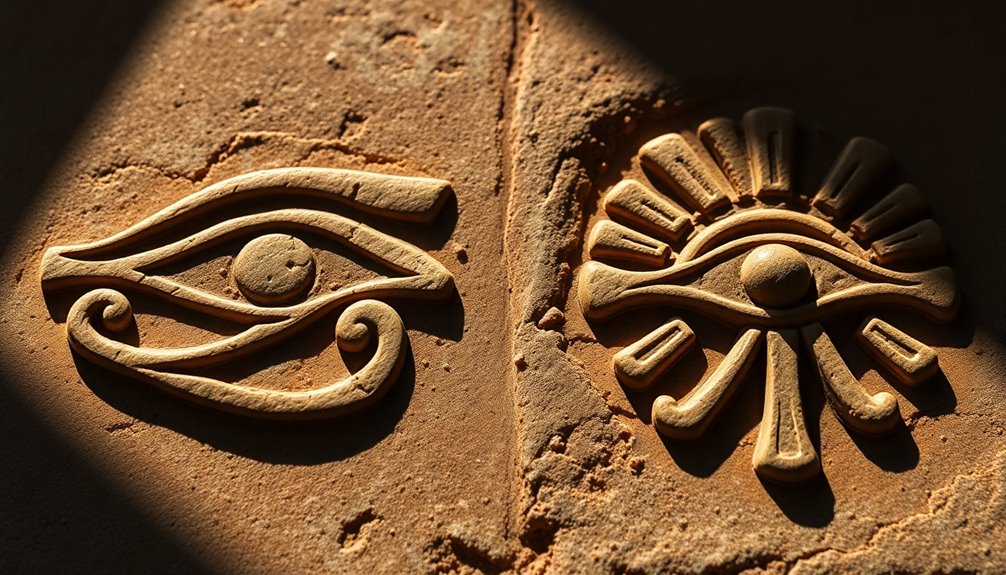
Both the Eye of Horus and the Eye of Ra hold significant places in ancient Egyptian mythology, yet they embody fundamentally different concepts.
The Eye of Horus, often associated with the moon, represents healing, protection, and wholeness. It's depicted as the left eye and is linked to the god Horus, symbolizing his victory over Set and the restoration of his eye. This symbol is widely used in amulets for personal protection and health, warding off evil and promoting well-being.
In contrast, the Eye of Ra, depicted as the right eye, embodies power and wrath, closely associated with the sun god Ra. This symbol reflects divine authority, instilling fear in enemies and serving as a reminder of punishment for disobedience, particularly through Ra's daughter.
While both symbols carry protective qualities, the Eye of Horus is more about safeguarding and healing, whereas the Eye of Ra focuses on power and vengeance in mythological contexts.
Ultimately, these ancient Egyptian symbols reflect deeper cultural significances, showcasing the balance between protection and authority in the belief systems of their time.
Cultural Impact and Legacy
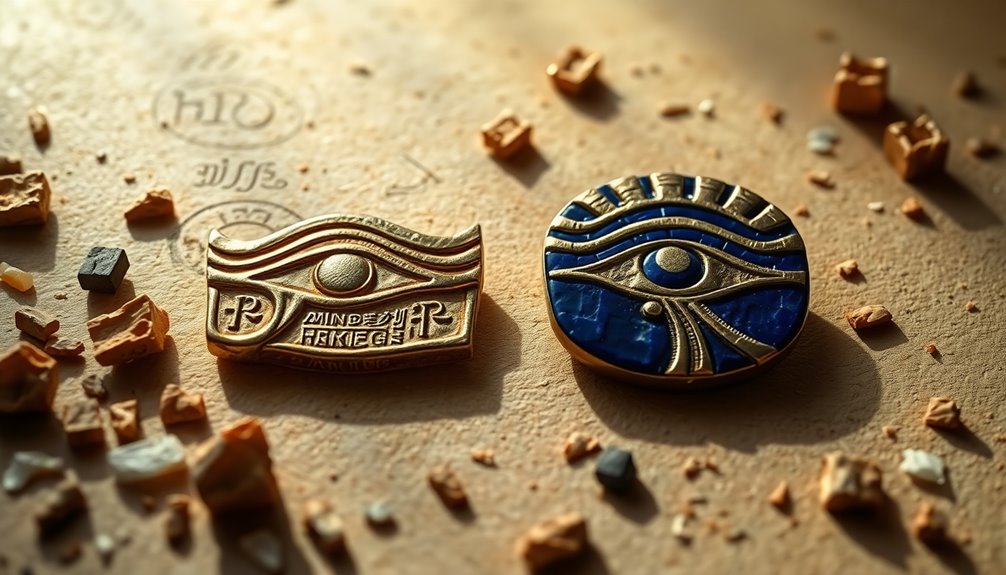
While the Eye of Horus and Eye of Ra have their roots in ancient Egyptian mythology, their cultural impact and legacy extend far beyond that era. These symbols represent powerful themes that resonate even today. Here are some key aspects of their influence:
- Artistic Inspiration: They've markedly influenced ancient Egyptian art, seen in jewelry, amulets, and temples.
- Symbolism of Duality: The Eye of Horus embodies healing and protection, while the Eye of Ra represents power and punishment.
- Afterlife Significance: The Eye of Horus was integral in artifacts like Tutankhamun's Coffin and the Rosetta Stone, emphasizing its role in afterlife rituals.
- Modern Adaptation: Today, these symbols appear in contemporary jewelry and tattoos, showcasing their enduring appeal.
The Eye of Horus and Eye of Ra not only reflect the rich mythology of ancient Egypt but also symbolize protection and power that continue to inspire spiritual practices and artistic expressions.
Their legacy thrives in academic studies and popular culture, proving that the allure of these ancient symbols is timeless.
Frequently Asked Questions
Which Is Better Eye of Ra or Eye of Horus?
When deciding which symbol is better, you should consider what you value most.
If you're drawn to healing, protection, and wisdom, you might prefer one symbol.
However, if you seek power, authority, and a fierce protector, the other could be more appealing.
Each symbol carries its own significance, so think about how they resonate with your beliefs and intentions.
Ultimately, the choice depends on what you want to embody in your life.
What Is the Power of the Eye of Ra?
What power does the Eye of Ra hold? This ancient symbol embodies the fierce strength of the sun god, Ra.
It represents divine authority and protection, punishing those who disrespect him. You can see its wrath in mythology, where it's depicted as a force that brings chaos to wrongdoers.
How Powerful Is the Eye of Horus?
The Eye of Horus is incredibly powerful, symbolizing protection, healing, and restoration.
When you wear or invoke this symbol, you're tapping into its ancient energy, believed to ward off evil and bring good fortune.
Its design, representing the six senses, reflects completeness, while the missing part signifies restoration.
Are Horus and Ra the Same God?
Horus and Ra aren't the same god; they represent different aspects of ancient Egyptian mythology.
You'll find Horus associated with the sky and kingship, while Ra embodies the sun and creation. Each has distinct symbols and functions within the pantheon.
Although Horus can be seen as a manifestation of Ra in some myths, they maintain separate identities and attributes that reflect their unique roles in Egyptian culture and religion.
Conclusion
In the tapestry of ancient Egypt, both the Eye of Horus and the Eye of Ra shimmer with power and significance. While Horus embodies protection and healing, Ra radiates the fierce energy of the sun. Ultimately, it's not just about which symbol reigns supreme; it's about how they intertwine to forge a legacy that transcends time. As you explore their meanings, you'll discover that each eye reflects a unique facet of the human experience, illuminating our journey through history.

